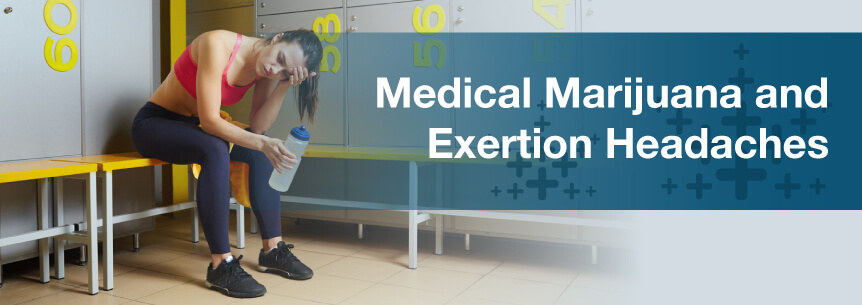
You already know cannabis helps with chronic pain, so it’s no wonder people are finding relief with medical marijuana for exertion headaches too. Continue reading to learn more about how cannabis can tackle even your worst exertion headache and its related symptoms.
Exertion headaches, also known as activity-related headaches and exercise headaches, are triggered by physical activity. They often occur during or after strenuous, sustained exercise. Some types of physical activity exertion headaches come from include:
Exercise headaches often affect younger people, starting in adolescence and continuing through 50 years of age. You typically get these types of headaches with extended exercise sessions, and often at the peak of your exercise routine. After you stop the exercise, the pain usually fades. But in some cases, you may experience the headache pain for up to two days. Exertion headaches cause similar symptoms to those from migraines, such as sensitivity to light and sound as well as nausea and vomiting. Some factors potentially contributing to your exertion headaches include:
Those suffering from exertion headaches often have a history of migraines in their family or get migraines themselves.
Three phases make up exertion headaches. They include:
An Intense Headache
This first phase is your painful headache, which starts in the middle of an intense workout or immediately after. You feel the pain in the back of your head or temples. It’s an exploding pain that hits suddenly and throbs painfully. It won’t dissipate until your heart rate lowers, blood pressure decreases and activity ceases.
A Dull Headache
The next phase is a fatiguing, dull ache lasting for a couple of weeks. Usually, it lingers where you felt the initial phase of your headache since that’s the area where the meninges flared.
A Full Recovery
A full recovery will depend on how severe your original headache was and the quality of rest you gave your body for recovering. If you’ve given your body the chance to heal, dull headaches will go away within a week. It could take up to two months for you to experience full recovery, or your body performing at the same level it was before the headache.
Physicians break exertion headaches into two main categories:
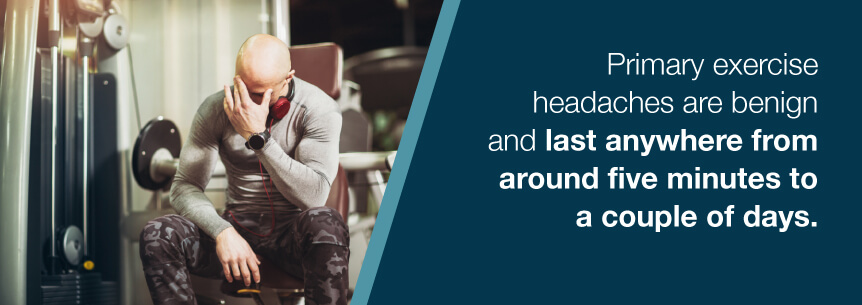
Secondary exertional headaches tend to occur in people in their forties and can last a few days. With secondary headaches, you may also experience neck rigidity, double vision or vomiting. They’re not to be taken lightly, and they require medical attention that may include an MRI scan.
Most exertion headaches are harmless and of primary nature. Your doctor may be able to prescribe preventive medication for you to take an hour or two before working out.
Exertion headaches aren’t new. In approximately 450 BC, Hippocrates wrote that you should know the difference between headaches from immoderate venery and headaches from running, walking, gymnastic exercises, hunting and other forms of labor. Even to this day, headaches within this scope are still a concern for those suffering with them.
The symptoms you experience depend on whether you have primary or secondary headaches. Primary exertion headaches:
Secondary exercise headaches cause:
If you begin experiencing one of these headaches while you’re exercising or after, talk with your doctor. If it’s the first time you’ve encountered this type of a headache, or it comes on abruptly, seek immediate medical attention.
Headaches are a common neurological symptom that neurologists and general practitioners see. They no doubt affect your quality of life. In some cases, individuals experience an occasional headache that goes away quickly.
Others, on the other hand, will suffer from more debilitating headaches. Because of the intensity and quality of pain they experience, they’ll have difficulty concentrating and both their home and work life will suffer. In many instances, individuals need to go to sleep to get rid of their headache. As you may know, sleeping can be hard to do when you’re experiencing pain.
As mentioned, exertion headaches create symptoms — like nausea, vomiting and sensitivity to sound and light — similar to those of migraines. Researchers and doctors link depression and anxiety to migraines. A study with 588 patients showed patients who had depression and anxiety experienced more frequent migraines.
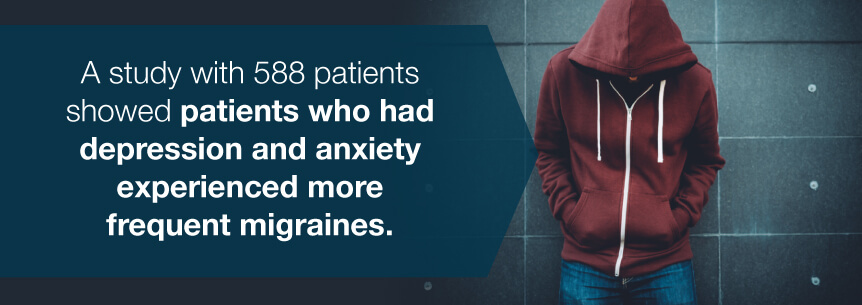
Researchers in the study made note that frequency of headaches and emotional distress might influence one another through a common pathophysiological means. For instance, emotional responses could change pain modulation and perception through specific signaling pathways. The study findings may suggest that effective medical intervention to reduce the frequency of headaches could reduce the risk of anxiety and depression in migraine patients.
Despite getting exertion headaches, you shouldn’t stop exercising. Physical activity is essential to help preserve your bone density and cardiovascular health. Exercising could also help reduce your risk of depression, and it helps to keep your body weight in check. However, you should warm up slowly before you exercise rather than simply jumping right into any strenuous activity.
Information reported about headaches from the National Center for Biotechnological Information (NCBI) covered:
The best treatment is preventing an exertion headache before it starts. These headaches often occur during humid and hot weather or during workouts at high altitudes. If you’re already susceptible to exertion headaches, you might not want to exercise in these types of conditions.
Some individuals experience these headaches only when they’re performing specific activities, so by avoiding these activities, they can prevent the headaches. Warming up before you begin vigorous exercise may also help prevent you from getting one of these headaches. Complete the following steps to ease the symptoms of your exertion headaches even more.
In some cases, you may need to adjust your exercise methods. Even small mistakes during a workout can bring on an exertion headache. Often, especially while running or lifting, people use incorrect posture. They’ll arch their back or sit with their head too far forward. By correcting your posture, you improve the flow of blood to your brain and decrease muscle tension.
While working too hard and excessive physical activity are the primary causes, exertion headaches also have triggers, just like migraines. Triggers may include:
If you don’t have any underlying vascular or structural problem causing your exertion headaches, your physician may prescribe certain medication to help prevent the headaches. You might be prescribed:
If you tend to get exertion headaches, you might be able to take medicine a couple hours before you begin working out or before a planned activity like a rigorous tennis match or a strenuous hike at a high altitude. If you can’t predict your headaches, you may just take preventive medication each day with your doctor’s recommendation.
Some people have reported that migraine headaches developed when they abruptly stopped long-term cannabis use. The conclusion was that cannabis was preventing migraines in susceptible people. Researchers believe weed was masking migraine pain. For a long time now, researchers and patients have experienced the analgesic properties of medical pot.
The Journal of Neuroscience provided a good explanation of why cannabis and triptans prevent migraine headaches. Your brain has endogenous, cannabis-like chemicals that produce analgesia by regulating how pain signals enter your brain at the spinal cord level. Manufacturers will likely create potential future pain medication based on the cannabis action in your body.
One benefit of targeting your endogenous cannabis system is that normal touch sensation doesn’t get blocked — only painful signals do. The study confirmed that the endogenous cannabis neurotransmitter system plays a role as a potential target to treat migraines. It also suggested that triptans activate your brain’s own endogenous, cannabis-like chemicals to relieve migraines.
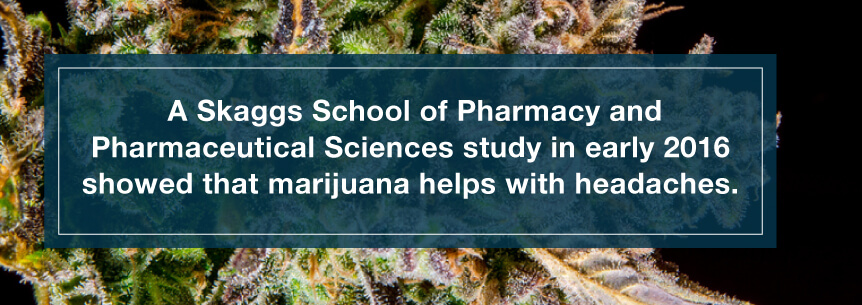
Medical marijuana has been treating migraines and headaches for a long time. A Skaggs School of Pharmacy and Pharmaceutical Sciences study in early 2016 showed that marijuana helps with headaches. This study investigated how effective marijuana is in treating migraines and found that the frequency of headaches each month was reduced by more than 50 percent — from 10.4 headaches each month to 4.6 headaches each month. Almost 85 percent of people involved in the study said each month, they experienced fewer migraines.
Medical cannabis for exertion headaches relieves certain symptoms such as:
The herb also helps:
Strains high in THC seem to have a more positive effect on the natural cannabinoid receptors in your brain. However, research still needs to be completed on each strain and how it treats headaches. Information on the strains below is based on anecdotal input. Users claim the best strains they’ve encountered for headaches include:
Sativas:
Indicas:
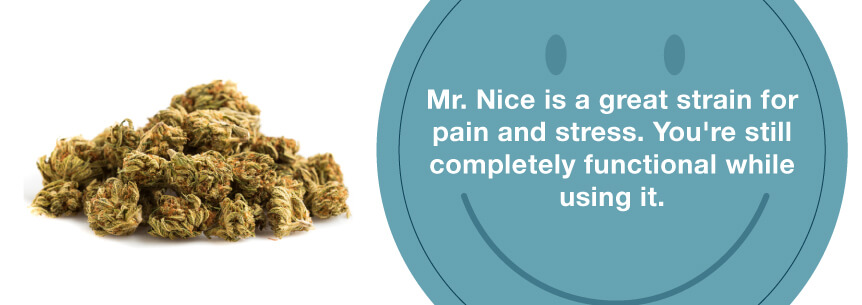
Hybrids:
When it comes to marijuana consumption for exertion headaches, you have more choices than ever. And, since new delivery systems to consume your medical pot pop up all the time, it may be difficult to realize which method will best relieve your headache. The oldest practice is smoking, but vaping is becoming more popular these days. You can also enjoy eating your marijuana in pretty much any food or try sprays, oils or many other options. Popular methods include:
Topical creams where you rub in your cannabis also exist. Most cannabis topicals contain cannabidiol (CBD) — marijuana’s truly medicinal cannabinoid. A huge plus of topicals is that you apply them directly to your skin on the precise area you need to feel better, like your forehead or temples.
Cannabis for exertion-headaches therapy is a natural, alternative treatment doctors give to patients to help relieve debilitating symptoms of diagnosed health conditions — in this case, exertion headaches — and improve quality of life. The more states legalize weed, the more dispensaries you’ll find to help fulfill your needs.
As more and more dispensaries open, you may find it overwhelming to decide which the best place is and which offers appropriate cannabis products. You may even find it hard to locate a doctor who will give you the recommendation you need to begin your medical-marijuana journey. The good news is that you can find a cannabis dispensary or search for a medical marijuana physician all under one roof here from Marijuana Doctors. We have experts standing by to help support you and answer your questions.
Find A Doctor Find A Dispensary